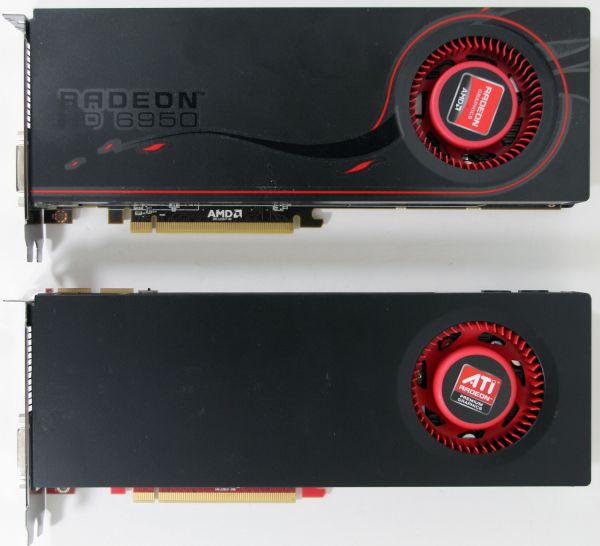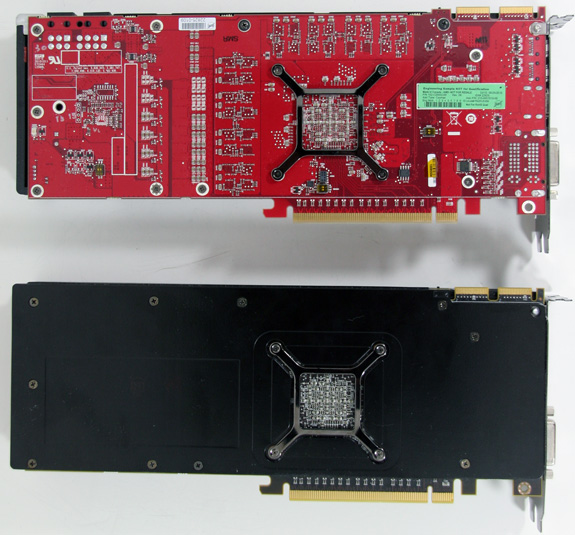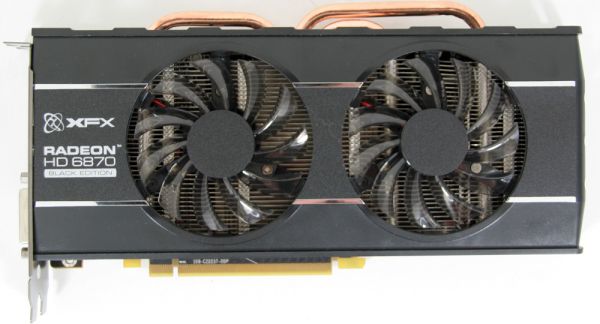AMD’s GTX 560 Ti Counter-Offensive: Radeon HD 6950 1GB & XFX’s Radeon HD 6870 Black Edition
by Ryan Smith on January 25, 2011 12:20 PM ESTMeet The Radeon HD 6950 1GB and XFX Radeon HD 6870 Black Edition
We’ll start our look at today’s cards with the headliner: AMD’s Radeon HD 6950 1GB. As we’ve previously established our 6950 is an engineering sample – perhaps an early one – so there’s not much to look at. Save for the kind of cosmetic defects you’d expect on an engineering sample, it’s for all practical purposes identical to the production 6950 2GB, and that’s intentional. AMD set out to make the 6950 1GB identical to the 6950 2GB other than the use of lower capacity GDDR5 chips, and this is what they have accomplished.

Top: 6950 2GB. Bottom: 6950 1GB Engineering Sample

Top: 6950 1GB Engineering Sample. Bottom: 6950 2GB
Since producing a 1GB card involves little more than replacing 2Gb memory chips with 1Gb memory chips, the true design innovations are going to come from AMD’s partners. Sapphire already has a 6950 1GB out with a custom cooler, and as AMD’s other partners get situated with 1GB cards we expect to see much of the same with them.
One item worth noting is that because our card is based on the reference design, it includes the BIOS switch at the top of the card. This means reference-based 1GB cards are going to have the same BIOS failsafe in them – however suitable BIOSes for the unlockers among you are another matter. Without some BIOS hacking (and possibly more), existing 6970 BIOSes are unsuitable as they’re meant for 2GB cards. Until such a time comes where a 6970 1GB BIOS can be developed, the 6950 1GB is not going to be a good card for unlocking. For the time being unlockers are going to want to stick to 2GB cards.
The Radeon HD 6950 1GB is launching with an MSRP of $259. At this time you can find reference-style 2GB cards for as little as $269, making the 1GB cards a rather simple $10 trade-off if you don’t mind mail-in rebates.
XFX Radeon HD 6870 Black Edition
Our second card of the day is XFX’s 2nd generation Radeon HD 6870 Black Edition (687A-ZDBC), the card that AMD originally proposed as the GTX 560 Ti’s competitor. Clocked at 940MHz core and 1150MHz (4.6Gbps data rate) memory, it runs at 40Mhz (4%) core and a 100MHz (9%) memory over the reference 6870. Overall this is a mild overclock, particularly as the 6870 is core-bound as opposed to memory-bound most of the time.
With such a mild overclock we had little reason to pay attention to the card, particularly once we completed our GTX 560 Ti benchmarking and saw that it was 10-20% faster than the stock-clocked 6870. Indeed it wasn’t until we tested the card that we saw something that grabbed our attention. Or perhaps I should say heard.
At the risk of spoiling the rest of our article, this card is for all practical purposes silent. At idle it’s only as loud as the noise floor of our GPU testbed, and at load – even under Furmark – it’s the same story. We measured 41.4dB at both idle and load, making it the quietest actively cooled mid-range card we have ever tested in our existing rig. Even the remarkably quiet GTX 460 can’t hold its ground to the 6870 Black Edition, it’s that quiet.
So what’s XFX’s secret? It’s much the same story as with the GTX 460. While the 6870 reference design uses a blower XFX is using an open-air cooler, specifically a double-fan cooler with 3 copper heatpipes that’s very similar to MSI’s Twin Frozor and Gigabyte’s Super Overclock cooler. Open-air coolers are already capable of being much quieter than blowers, and when done correctly a double-fan arrangement can be quieter than driving a single fan at higher speeds. Combining this highly effective cooler with the 6870’s Black Edition’s low TDP (~160W) results in a very quiet card that by all indications cannot be beaten at this point in time.
Rounding out the package, there are no real meaningful extras to discuss. Aside from some trinkets (stickers, case badges, etc), the only other piece of hardware in the box is a short CrossFire bridge. XFX has kept it simple: the only things that really matter are the card and XFX’s lifetime warranty.
The Radeon HD 6870 Black Edition doesn’t have a set MSRP, but it’s currently available for around $229 with a mail-in rebate, making it roughly $10 more expensive than a stock-clocked card. Or compared to XFX’s lineup, the non-Black Edition version of this card is a mere $4 less at $225; so you’re looking at a $4 factory overclock and $6 for a supurb custom cooler.












111 Comments
View All Comments
Ryan Smith - Wednesday, January 26, 2011 - link
Indeed CPU bottlenecking is a concern, and we always try to remove it as much as possible. Replacing the CPU means throwing out our entire body of work, so as important as it is to avoid being CPU bottlenecked, we can't do it frequently.The issue for us right now is that SNB-E isn't due until late this year, and that's the obvious upgrade path for our GPU testbed since SNB has a limited amount of PCIe bandwidth.
7upMan - Wednesday, January 26, 2011 - link
RYAN: Hi Ryan, while I usually find AnandTech articles quite entertaining and informative, I always wonder why the f*ck professional editors won't get it into their head to test 2GB cards in areas where they belong to. Meaning: a 2GB vs. 1 GB card test should be about graphically overly intensive games and game mods, like the Half-Life 2 Fake Factory mod, or the STALKER Complete mod (Oblivion too has such mods). There are a number of other mods that put massive numbers of huge textures into the graphics RAM, and I think they should be the ones you need to test the cards with. After all, you can't expect games that were written with 1GB VRAM in mind to utilize the full power of double VRAM.So please, please run some tests with the above mentioned mods. Thanks in advance.
IceDread - Wednesday, January 26, 2011 - link
Good reviewAs a sidenote, sort of fun to see my one year old card 5970 is still the best when looking at single cards.
IceDread - Wednesday, January 26, 2011 - link
There was not much talk about SLI and crossfire btw, there the value in AMD is higher today day with a fair bit than with SLi solutions comparing AMD 6xxx series with new nvidia cards.Ryan Smith - Wednesday, January 26, 2011 - link
We had to leave our SLI & CF for this article because of all the driver changes from both parties - as it stands I need to rerun most of those numbers.You'll be seeing a lot more on SLI and CF in a week or two; we have a trio of 580s and 6970s in house for some tri-SLI/CF testing.
Scootiep7 - Wednesday, January 26, 2011 - link
Not going to add much to the discourse at this point. I just want to say that I really liked this article and thank you for your time and due diligence in writing it.blackshard - Wednesday, January 26, 2011 - link
Why they are so different from previous articles? NVIDIA numbers have grown about three times and some AMD numbers are grown too.Previous article about HD6950 and HD6970 showed this:
http://www.anandtech.com/show/4061/amds-radeon-hd-...
Ryan Smith - Wednesday, January 26, 2011 - link
In the GTX 560 Ti article I explained what was going on.http://www.anandtech.com/show/4135/nvidias-geforce...
"Small Lux GPU is the other test in our suite where NVIDIA’s drivers significantly revised our numbers. Where this test previously favored raw theoretical performance, giving the vector-based Radeons an advantage, NVIDIA has now shot well ahead. Given the rough state of both AMD and NVIDIA’s OpenCL drivers, we’re attributing this to bug fixes or possibly enhancements in NVIDIA’s OpenCL driver, with the former seeming particularly likely. However NVIDIA is not alone when it comes to driver fixes, and AMD has seem a similar uptick against the newly released 6900 series. It’s not nearly the leap NVIDIA saw, but it’s good for around 25%-30% more rays/second under SLG. This appears to be accountable to further refinement of AMD’s VLIW4 shader compiler, which as we have previously mentioned stands to gain a good deal of performance as AMD works on optimizing it."
blackshard - Wednesday, January 26, 2011 - link
Ok, got it. I have not read the gtx560 review. Thanks ;)ibudic1 - Wednesday, January 26, 2011 - link
Don't forget that you can unlock 6950 to 6970, at which point Nvidia is just NOT competitive.http://www.techpowerup.com/137140/AMD-Radeon-HD-69...